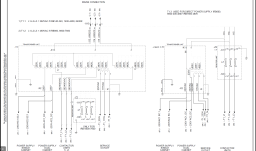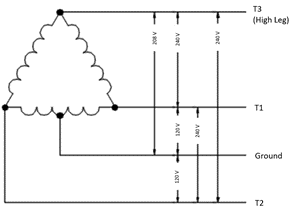StoneMachines
Plastic
- Joined
- Jan 28, 2012
- Location
- Ottawa,ON,Canada
Hello,
Looking for some guidance on supplying power to a machine.
Power Source - Typical North American residential single phase 240volt.
Machine requirements 480v 3 phase.
Was hoping to use a Phase Perfect with the voltage doubling feature so I do not need a transformer.
The manual for the machine to be powered shows, and the physical input terminals only have, 3 wires + ground
However the machine manual states:
If the machine doesn't require a neutral why would the manual state this?
I've looked at the schematic.
This is the input terminal connection:

From there to an internal transformer (right side):

It does show a 115v circuit on the output of the internal transformer, but referenced to ground not a supplied neutral. From the transformer some 230v single phase circuits go to DC power power supplies. The 480v 3 phase is passed to a rectifier

The only place the internal generated 115v/internal neutral go to are a service port, which could be disabled if that is the only thing requiring reference to ground.

If I took care to wire the "pass through" (non generated legs) of the phase perfect to the terminals (appears to be L1, L2) that feed the 230v single phase power supplies I should be OK? The rectifier shouldn't be affected by the high leg?
My understanding is that the Phase Perfect supplies a delta source (from their FAQ):
Why is the output voltage on one leg of my 240 V phase converter 208 V to ground?
A: For a phase converter to generate three-phase power, the two incoming power lines are directly passed through to the output and the phase converter generates the third leg in a configuration known as “high-leg delta.” This will power most three-phase machines. Some machines however require wye-configured power, which includes a neutral. If your machine requires wye-configured power, you will need to send the output of the phase converter through a delta-to-wye transformer before the load. In the graphic below, T3 is the generated leg.
 Figure 2 – High Leg Delta
Figure 2 – High Leg Delta
I know just buy the right transformer, but money
Thanks
Greg.
Looking for some guidance on supplying power to a machine.
Power Source - Typical North American residential single phase 240volt.
Machine requirements 480v 3 phase.
Was hoping to use a Phase Perfect with the voltage doubling feature so I do not need a transformer.
The manual for the machine to be powered shows, and the physical input terminals only have, 3 wires + ground
However the machine manual states:
This is a used machine well out of warranty, but I don't want to damage anything.The use of three phase power with delta connection (as sometimes used in North
Americas and some Asian countries) voids warranty. If the facility has a substation
with any type of delta connection, a grounded Y-configured transformer must be
installed before the robot controller
If the machine doesn't require a neutral why would the manual state this?
I've looked at the schematic.
This is the input terminal connection:

From there to an internal transformer (right side):

It does show a 115v circuit on the output of the internal transformer, but referenced to ground not a supplied neutral. From the transformer some 230v single phase circuits go to DC power power supplies. The 480v 3 phase is passed to a rectifier

The only place the internal generated 115v/internal neutral go to are a service port, which could be disabled if that is the only thing requiring reference to ground.

If I took care to wire the "pass through" (non generated legs) of the phase perfect to the terminals (appears to be L1, L2) that feed the 230v single phase power supplies I should be OK? The rectifier shouldn't be affected by the high leg?
My understanding is that the Phase Perfect supplies a delta source (from their FAQ):
Why is the output voltage on one leg of my 240 V phase converter 208 V to ground?
A: For a phase converter to generate three-phase power, the two incoming power lines are directly passed through to the output and the phase converter generates the third leg in a configuration known as “high-leg delta.” This will power most three-phase machines. Some machines however require wye-configured power, which includes a neutral. If your machine requires wye-configured power, you will need to send the output of the phase converter through a delta-to-wye transformer before the load. In the graphic below, T3 is the generated leg.

I know just buy the right transformer, but money

Thanks
Greg.

